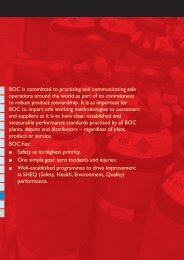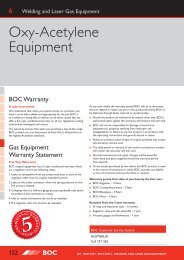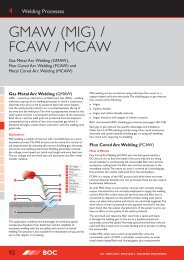SAFETY-Risk Assessment.pdf - BOC World of Welding
SAFETY-Risk Assessment.pdf - BOC World of Welding
SAFETY-Risk Assessment.pdf - BOC World of Welding
You also want an ePaper? Increase the reach of your titles
YUMPU automatically turns print PDFs into web optimized ePapers that Google loves.
Safety Products Reference Manual<br />
Safety in the Workplace<br />
The information below is provided as a general outline and is not intended to be a definitive statement on the subject<br />
matter. Pr<strong>of</strong>essional advice should be sought before any action is taken in relation to the matters described below.<br />
What is risk assessment<br />
A risk assessment is simply a careful examination <strong>of</strong> what, in your<br />
work, could cause harm to people, so that you can weigh up<br />
whether you have taken enough precautions or should do more<br />
to prevent harm. Workers and others have a right to be protected<br />
from harm caused by a failure to take reasonable control measures.<br />
Accidents and ill health can ruin lives and affect your business too<br />
if output is lost, machinery is damaged, insurance costs increase<br />
or you have to go to court. You are legally required to assess the<br />
risks in your workplace so that you put in place a plan to control<br />
the risks.<br />
How to assess the risks in your workplace<br />
1<br />
2<br />
3<br />
4<br />
5<br />
Identify the hazards<br />
Decide who might be harmed and how<br />
Evaluate the risks and decide on precautions<br />
Record your findings and implement them<br />
Review your risk assessment and update if necessary<br />
Don’t overcomplicate the process. In many organisations, the risks<br />
are well known and the necessary control measures are easy to<br />
apply. You probably already know whether, for example, you have<br />
employees who move heavy loads and so could harm their backs,<br />
or where people are most likely to slip or trip. If so, check that you<br />
have taken reasonable precautions to avoid injury.<br />
If you work in a larger organisation, you could ask a health and<br />
safety advisor to help you. If you are not confident, get help from<br />
someone who is competent. In all cases, you should make sure that<br />
you involve your staff or their representatives in the process. They<br />
will have useful information about how the work is done that will<br />
make your assessment <strong>of</strong> the risk more thorough and effective. But<br />
remember, you are responsible for seeing that the assessment is<br />
carried out properly.<br />
When thinking about your risk assessment, remember:<br />
■■ a hazard is anything that may cause harm, such as chemicals,<br />
electricity, working from ladders, an open drawer etc;<br />
■■ the risk is the chance, high or low, that somebody could be<br />
harmed by these and other hazards, together with an indication<br />
<strong>of</strong> how serious the harm could be.<br />
1<br />
Identify the hazards<br />
First you need to work out how people could be harmed. When you<br />
work in a place every day it is easy to overlook some hazards, so<br />
here are some tips to help you identify the ones that matter:<br />
■■ Walk around your workplace and look at what<br />
could reasonably be expected to cause harm.<br />
■■ Ask your employees or their representatives<br />
what they think. They may have noticed things<br />
that are not immediately obvious to you.<br />
■■ If you are a member <strong>of</strong> a trade association, contact<br />
them. Many produce very helpful guidance.<br />
■■ Check manufacturers’ instructions or data sheets for chemicals<br />
and equipment as they can be very helpful in spelling out<br />
the hazards and putting them in their true perspective.<br />
■■ Have a look back at your accident and ill-health records<br />
– these <strong>of</strong>ten help to identify the less obvious hazards.<br />
■■ Remember to think about long-term hazards to<br />
health (e.g. high levels <strong>of</strong> noise or exposure to<br />
harmful substances) as well as safety hazards.<br />
2<br />
Decide who might be harmed and how<br />
For each hazard you need to be clear about who might be harmed;<br />
it will help you identify the best way <strong>of</strong> managing the risk. That<br />
doesn’t mean listing everyone by name, but rather identifying groups<br />
<strong>of</strong> people (e.g.‘people working in the storeroom’ or ‘passers-by’).<br />
In each case, identify how they might be harmed, ie what type <strong>of</strong><br />
injury or ill health might occur. For example, ‘shelf stackers may<br />
suffer back injury from repeated lifting <strong>of</strong> boxes’.<br />
8 AU : SPRM 2009 : Introduction
Safety Products Reference Manual<br />
Remember:<br />
■■<br />
■■<br />
■■<br />
■■<br />
■■<br />
some workers have particular requirements, e.g.<br />
new and young workers, new or expectant mothers<br />
and people with disabilities may be at particular risk.<br />
Extra thought will be needed for some hazards;<br />
cleaners, visitors, contractors, maintenance workers<br />
etc, who may not be in the workplace all the time;<br />
members <strong>of</strong> the public, if they could be hurt by your activities;<br />
if you share your workplace, you will need to think about<br />
how your work affects others present, as well as how<br />
their work affects your staff – talk to them; and<br />
ask your staff if they can think <strong>of</strong> anyone you may have missed.<br />
3<br />
Evaluate the risks and decide on precautions<br />
Having spotted the hazards, you then have to decide what to do<br />
about them. The law requires you to do everything ‘reasonably<br />
practicable’ to protect people from harm. You can work this out for<br />
yourself, but the easiest way is to compare what you are doing with<br />
good practice.<br />
So first, look at what you’re already doing, think about what controls<br />
you have in place and how the work is organised. Then compare this<br />
with the good practice and see if there’s more you should be doing<br />
to bring yourself up to standard. In asking yourself this, consider:<br />
■■ Can I get rid <strong>of</strong> the hazard altogether<br />
■■ If not, how can I control the risks so that harm is unlikely<br />
■■ When controlling risks, apply the principles<br />
below, if possible in the following order:<br />
■■ try a less risky option (e.g. switch to using<br />
a less hazardous chemical);<br />
■■ prevent access to the hazard (e.g. by guarding);<br />
■■ organise work to reduce exposure to the hazard (e.g.<br />
put barriers between pedestrians and traffic);<br />
■■ issue personal protective equipment (e.g.<br />
clothing, footwear, goggles etc); and<br />
■■ provide welfare facilities (e.g. first aid and washing<br />
facilities for removal <strong>of</strong> contamination).<br />
Improving health and safety need not cost a lot. For instance, placing<br />
a mirror on a dangerous blind corner to help prevent vehicle<br />
accidents is a low-cost precaution considering the risks. Failure<br />
to take simple precautions can cost you a lot more if an accident<br />
does happen.<br />
Involve staff, so that you can be sure that what you propose to do<br />
will work in practice and won’t introduce any new hazards.<br />
4<br />
Record your findings and implement them<br />
Putting the results <strong>of</strong> your risk assessment into practice will make a<br />
difference when looking after people and your business.<br />
Writing down the results <strong>of</strong> your risk assessment, and sharing them<br />
with your staff, encourages you to do this. If you have fewer than<br />
five employees you do not have to write anything down, though<br />
it is useful so that you can review it at a later date if, for example,<br />
something changes.<br />
When writing down your results, keep it simple, for example<br />
‘Tripping over rubbish: bins provided, staff instructed, weekly<br />
housekeeping checks’, or ‘Fume from welding: local exhaust<br />
ventilation used and regularly checked’.<br />
It is not expected that a risk assessment to be perfect, but it must<br />
be suitable and sufficient. You need to be able to show that:<br />
■■ a proper check was made;<br />
■■ you asked who might be affected;<br />
■■ you dealt with all the significant hazards, taking into<br />
account the number <strong>of</strong> people who could be involved;<br />
■■ the precautions are reasonable, and the remaining risk is low; and<br />
■■ you involved your staff or their representatives in the process.<br />
If you find that there are quite a lot <strong>of</strong> improvements that you could<br />
make, big and small, don’t try to do everything at once. Make a plan<br />
<strong>of</strong> action to deal with the most important things first.<br />
A good plan <strong>of</strong> action <strong>of</strong>ten includes a mixture <strong>of</strong> different things<br />
such as:<br />
■■ a few cheap or easy improvements that can be<br />
done quickly, perhaps as a temporary solution<br />
until more reliable controls are in place;<br />
■■ long-term solutions to those risks most<br />
likely to cause accidents or ill health;<br />
■■ long-term solutions to those risks with the<br />
worst potential consequences;<br />
■■ arrangements for training employees on the main risks<br />
that remain and how they are to be controlled;<br />
■■ regular checks to make sure that the<br />
control measures stay in place; and<br />
■■ clear responsibilities – who will lead on what action, and by when.<br />
Remember, prioritise and tackle the most important things first.<br />
5<br />
Review your risk assessment and update if necessary<br />
Few workplaces stay the same. Sooner or later, you will bring in<br />
new equipment, substances and procedures that could lead to new<br />
hazards. It makes sense, therefore, to review what you are doing on<br />
an ongoing basis. Every year or so formally review where you are, to<br />
make sure you are still improving, or at least not sliding back.<br />
Look at your risk assessment again. Have there been any changes<br />
Are there improvements you still need to make Have your workers<br />
spotted a problem Have you learnt anything from accidents or near<br />
misses Make sure your risk assessment stays up to date.<br />
During the year, if there is a significant change, don’t wait. Check<br />
your risk assessment and, where necessary, amend it. If possible, it is<br />
best to think about the risk assessment when you’re planning your<br />
change – that way you leave yourself more flexibility.<br />
Source: Five Steps to <strong>Risk</strong> <strong>Assessment</strong> (published by Health and Safety Executive June 2006). Crown Copyright.<br />
AU : SPRM 2009 : Introduction<br />
9
















